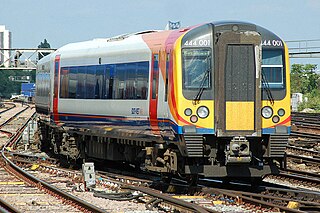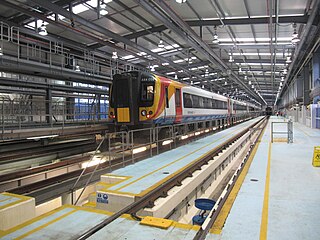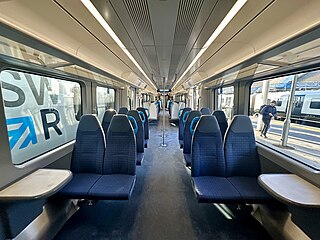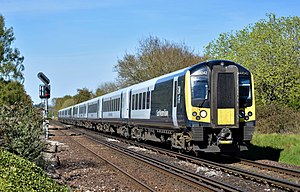
Stagecoach South Western Trains Limited, trading as South West Trains (SWT), was an English train operating company owned by Stagecoach, which operated the South Western franchise between February 1996 and August 2017.

The Siemens Desiro is a family of diesel or electric multiple unit passenger trains developed by Siemens Mobility, a division of the German Siemens AG conglomerate. The main variants are the Desiro Classic, Desiro ML, Desiro UK and the later Desiro City, Desiro HC and Desiro RUS. The trains are mostly used for commuter and regional services, and their rapid acceleration makes them suitable for services with short distances between stations. The design is flexible, and has become common in many European countries.

The British RailClass 411 (4CEP) electric multiple units were built at Eastleigh works from 1956–63 for the newly electrified main lines in Kent. These units, which used a British Railways Mark 1 bodyshell, were based on the earlier Southern Railway 4 COR design, built in 1937. Variants of the class 411 design included the class 410 and class 412 4 BEP units, which contained a buffet car in place of a standard trailer. They were later used on services in Sussex and Hampshire; following the privatisation of British Rail in 1995, the units were used by the Connex South Central, Connex South Eastern and South West Trains franchises. They were replaced by Juniper, Desiro, and Electrostar units. The fleet's lifespan was 49 years. These units are the longest-lived BR Mark 1 EMUs.

The British Rail Class 423, electric multiple unit passenger trains were mostly built by British Rail (BR) at York Works from 1967 to 1974, although the MBSOs and TSOs of the first 20, 7701-7720, were built at Derby Works. They have manually opening doors next to every seating row and were the last coaching stock built in this pattern for BR. They were mostly found working outer-suburban services in South London and rural services in Kent, Sussex and Hampshire, up to 2005 when they were finally replaced by Electrostar and Desiro units. The fleet had a working life of 38 years.

The British Rail Class 456 was an electric multiple unit passenger train introduced by Network SouthEast on inner-suburban services in South London to replace the elderly Class 416 2EPB units. Twenty-four two-car units were built by British Rail Engineering Limited's York Carriage Works in 1990 and 1991.

The British Rail Class 460 Juniper (8-GAT) was a class of electric multiple-unit passenger trains built by Alstom at Washwood Heath between 1999 and 2001. They were part of Alstom's Coradia Juniper family, which also includes Classes 334 and 458.

The British Rail Class 458 Juniper (5-JUP) is a class of electric multiple unit passenger trains of the Alstom Coradia Juniper family, built at Washwood Heath between 1998 and 2002 for South West Trains. The order for the original fleet of 30 four-car trains was placed in 1997, and delivery of the first unit followed in October 1998. The fleet entered passenger service between 2000 and 2003 and is maintained at Wimbledon depot.

The British Rail Class 450 Desiro are third-rail DC electric multiple unit (EMU) passenger trains that entered service during 2003. Used for outer-suburban services, they were built with both first- and standard-class accommodation. They have a maximum speed of 100 mph (160 km/h).

The South West Main Line (SWML) is a 143-mile major railway line between Waterloo station in central London and Weymouth on the south coast of England. A predominantly passenger line, it serves many commuter areas including south western suburbs of London and the conurbations based on Southampton and Bournemouth. It runs through the counties of Surrey, Hampshire and Dorset. It forms the core of the network built by the London and South Western Railway, today mostly operated by South Western Railway.

The British Rail Class 442 (5-WES) Wessex Electrics were electric multiple unit passenger trains introduced in 1988 by Network SouthEast on the South West Main Line from London Waterloo to Weymouth to coincide with the electrification of the line from Bournemouth. Twenty-four five-car units were built by British Rail Engineering Limited's Derby Litchurch Lane Works.

The British Rail Class 350 Desiro is a class of electric multiple unit passenger train built by Siemens Transportation Systems to its Desiro design between 2004 and 2014. All 87 are now operated by West Midlands Trains, having previously been operated by Central Trains, Silverlink, Southern, London Midland, First TransPennine Express and TransPennine Express (FirstGroup).

The British Rail Class 455 is an electric multiple unit passenger train built by BREL between 1982 and 1985. It is operated on suburban services in Greater London and Surrey by South Western Railway, as well as formerly by Southern.

Christchurch railway station serves the town of Christchurch in Dorset, England. The station is on the London Waterloo to Weymouth line operated by South Western Railway. It is 104 miles 28 chains (167.9 km) down the line from Waterloo.

Poole railway station is on the South West Main Line serving the town of Poole in Dorset, England. It is situated in the town centre next to Holes Bay. It is one of four stations in the Borough of Poole and is 113 miles 62 chains (183.1 km) down the main line from London Waterloo.

The Alstom Coradia Juniper series is a family of electric multiple unit trains built by Alstom Transport Birmingham for use on the railway network in Great Britain. The family is related to the Coradia 1000 series of diesel multiple units.

The British Rail Class 380 Desiro is a type of electric multiple unit passenger train that operates on the National Rail network in Scotland, for ScotRail.

The British Rail Class 707 Desiro City is an electric multiple unit passenger train. Siemens Mobility built 30 five-carriage sets, initially leased by South West Trains. SWT's franchise successor South Western Railway began phasing them out from September 2021. Twenty-eight sets are now in service with Southeastern having been transferred from South Western Railway by late 2023, with two sets remaining at South Western Railway.

Northam Traincare Facility, also known as Northam Carriage Servicing Depot, is an electric traction maintenance depot in the suburb of Northam in Southampton, England. The depot is situated on the South West Main Line and is south of St Denys station at Northam Junction. Two tracks on the formation of the branch to the Eastern Docks are used as the depot headshunt and extra berthing sidings. It is the principal maintenance facility for the Class 444 and 450s operated by South Western Railway.

South Western Railway is a British train operating company owned by FirstGroup (70%) and MTR Corporation (30%) that operates the South Western franchise.

The British Rail Class 701 Aventra is a class of electric multiple unit passenger train built by Bombardier Transportation at Derby Litchurch Lane Works. Built on the Aventra platform, they are branded as Arterio trains by SWR, and operate some services between Waterloo and Windsor. In the future the trains are planned to operate services on the Reading, Windsor and South West London suburban lines.




























